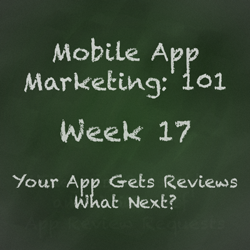From the mundane “Get Your Family to Download Your App” to the off the wall “Create Beer Coasters” join us on a 52-week journey of some of the top ways to promote and market your mobile application.
Mobile App Marketing: Your App Is Getting Reviews – Now What?
 Once the reviews from writers and bloggers have begun rolling in, there’s no better time than the present to start spreading the word about your app’s positive press attention. In that vein, this week we’ll take a look at how to use reviews to gain maximum exposure for your app.
Once the reviews from writers and bloggers have begun rolling in, there’s no better time than the present to start spreading the word about your app’s positive press attention. In that vein, this week we’ll take a look at how to use reviews to gain maximum exposure for your app.
Broadcast To Your Followers
It’s in your best interest to let as many people as possible know about the positive press your application is receiving; consequently, it’s important to spread the news of the review across as many different channels as you can. This includes your Facebook and Twitter pages, in addition to more traditional mediums like your company website and through email blasts.
Reviews provide ideal content for Facebook – all you need is a quote, relevant image, and a link to the review. Package it all together, and you have the perfect post for letting your friends and followers know about the positive attention that your project is receiving. It’s also worthwhile to consider sharing content from the review site themselves – this approach allows you to make the most of both the review site’s credibility and objectivity. Although you are promoting your product by sharing this content, your viewers will interpret it as coming from the review site, and not necessarily from your company.
If you’re running ads on the social network, you might consider including a quote from the review in your ad copy. However, it’s important to check with the review site to see if this is permitted.
Since many review sites work on the basis of attracting pageviews with their content, it’s a fairly common practice to post a tweet when a new review has been released. Not only does this expose your app to the site’s followers, but you can then retweet the site to spread the word of the review to your own followers.
Review-linking tweets are especially helpful because they allow you to market your product without having to dilute your own brand’s visibility in the Twitter feeds of your followers. Nobody enjoys seeing the same company logo pop up time and time again in their feed; by retweeting review sites, you can avoid this pratfall while still getting the word out about your app.
Ahh, yes, the old-fashioned email blast. Although email blasts are not as commonly used as they once were, they still has some merit for the purposes of promoting your app. In particular, email lets you capitalize upon the familiarity that some readers may have with a review site. If a particularly large site like Mashable or TechCrunch gives an enthusiastic review about your app, you can put that right in the subject line – “Mashable Loves Our App!” – causing them to open your email and see the good news.
iTunes/Google Play
When it comes time to upload the latest version of your app, be sure to include the positive review in its listing on the iTunes or Google Play store. The review will lend credibility to your own marketing copy, letting users see that the app really can do what it claims to do.
After The Review is Posted
If a reviewer has taken the time to review and write about your product, it’s always a good professional courtesy to write them and thank them for their work. More importantly, this allows you to build a rapport with both the writer and the website that hosted the review, which in turn may make it easier to generate future reviews. If writers can rely on you for a good story lead, it will be that much easier to garner press attention for your future app projects.
Reviews Are Assets
Good reviews are effectively permanent testaments to the benefits and features of your app. Therefore, even after the initial glow fades away, it’s important to keep reiterating and re-emphasizing the positive press your app received. Review broadcasts are not “fire and forget” – like any other marketing initiative, they require ongoing adjustment and investment.
When the downloads start rolling in, you’ll inevitably ask yourself how to capitalize upon your success. Check back next week to see the best ways to monetize your mobile app.
As always, you can follow us on Twitter and Facebook to stay in the loop.
The 52 Week Series of Marketing Mobile Applications
Week 1: Talk to Friends & Family
Week 2: Picking the Right Name for Your App
Week 3: App Store Optimization
Week 4: Submitting Your App to Review Sites, Blogs, and Directories
Week 5: Using Video to Promote Your App
Week 6: Creating a Microsite
Week 7: Creating a Press Kit
Week 8: Creating a Marketing Plan
Week 9: Social Media: Facebook
Week 10: Social Media: Twitter
Week 11: Social Media: Other Platforms
Week 12: Social Media: Managing Your Social Media Presence
Week 13: Social Media: Reaching out to Bloggers & Reviewers
Week 14: Finding What Makes Your App Unique
Week 15: The Ins, Outs, Ups, and Downs of App Review Requests
Week 16: Using Promo Codes
Week 17: What To Do When You Start Getting Reviews
Week 18: Monetizing Your Mobile App: Pay Per Download






